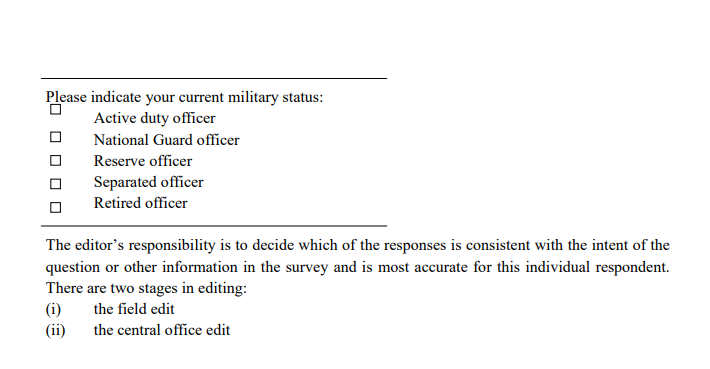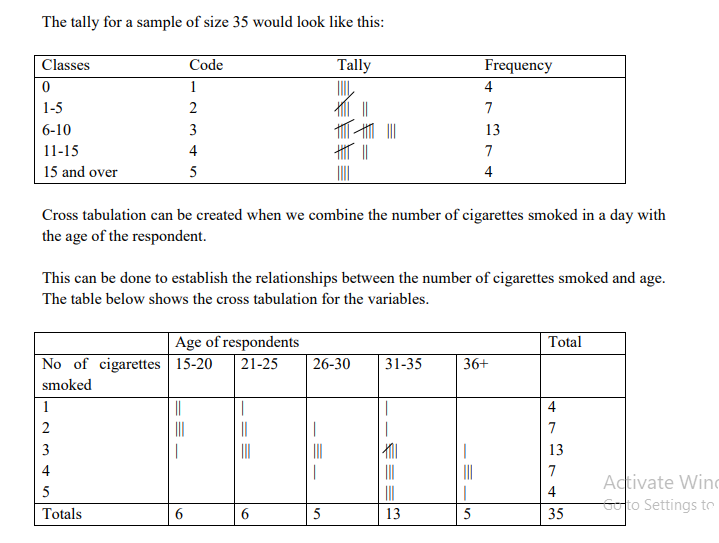Once the data begin to flow in, attention turns to data analysis. The steps followed in data collection influence the choice of data analysis techniques. The main preliminary steps that are common to many studies are:
Editing
Coding and
Tabulation
1. Editing
Editing involves checking the raw data to eliminate errors or points of confusion in data. The main purpose of editing is to set quality standards on the raw data, so that the analysis can take place with minimum of confusion. In other words, editing detects errors and omissions, corrects them when possible and certifies that minimum data quality standards are achieved. The editor’s
purpose is to guarantee that data are:
• Accurate
• Consistent with other information
• Uniformly entered
• Complete and
• Arranged to simplify coding and tabulation.
In the following questions asked of military officers, one respondent checked two categories, indicating that he was in the reserves and currently serving on active duty.

The Field Edit
Field edit is the preliminary edit whose main purpose is to detect the obvious inaccuracies and omissions in the data. This also helps the researcher to control the fieldworkers and to clear misunderstandings of the procedures and of specific questions.
The best arrangement is to have the field edit conducted soon after the data collection form has been administered. The following items are checked in the field edit:
- Completeness: Checking the data form to ensure that all the questions have been answered. The respondent may refuse to answer some questions or may just not notice them.
- Legibility: A questionnaire may be difficult to read owing to the interviewer’s handwriting or the uses of abbreviations not understood by respondents.
- Clarity: A response may be difficult for others to comprehend but the interviewer can easily clarify it, if asked in good time.
- Consistency: The responses provided may also lack consistency. These can be corrected by the fieldworker if detected early.
In large projects, field editing review is a responsibility of the field supervisor. It, too, should be done soon after the data have been gathered. A second important control function of the field supervisor is to validate the field results. This normally means s/he will re-interview some percentage of the respondent, at least on some questions.
Central Editing
This comes after the field edit. At this point, data should get a thorough editing. Sometimes it is obvious that an entry is incorrect, is entered in the wrong place or states time in months when it was requested in weeks. A more difficult problem concerns faking; Arm chair interviewing is difficult to spot, but the editor is in the best position to do so. One approach is to check responses to open-ended questions. These are the most difficult to fake. Distinctive response patterns in other questions will often emerge if faking is occuring. To uncover this, the editor must analyse the instruments used by each interviewer.
2. Coding
It involves assigning numbers or other symbols to answers so the responses can be grouped into a limited number of classes or categories. The classifying of data into limited categories sacrifices some data detail but is necessary for efficient analysis. Instead of requesting the work male or female in response to a question that asks for the identification of one’s gender, we could use the codes ‘M’ or ‘F’. Normally, this variable would be coded 1 for male and 2 for female or 0 and 1. Coding helps the researcher to reduce several thousand replies to a few categories containing the critical information needed for analysis.
The first step involves the attempt to determine the appropriate categories into which the responses are to be placed. Since multiple choice and dichotomous questionnaire have specified alternative responses, coding the responses of such questions is easy. It simply involves assigning a different numerical code to each different response category. Open questions present different kinds of problems for the editors. The editor has to categorise the responses first and then each question is reviewed to identify the category into which it is to be placed. There is a problem in that there can be a very wide range of responses, some of which are not anticipated at all. To ensure consistency in coding, the task of coding should be apportioned by questions and not by questionnaires. That is, one person may handle question one to six, in all the questionnaires instead of dividing the coding exercise by questionnaires.
The next step involves assigning the code numbers to the established categories. For example, a question may demand that a respondent lists the factors s/he considers when buying a pair of shoes. The respondent is free to indicate anything s/he thinks of. The responses may range from colour, size, comfort, price, materials, quality, durability, style, uniqueness and manufacturer among others. The response may have to be coded into just three or four categories and each response has to be placed within a specific category and coded as such. The ‘don’t know’ (DK) response presents special problems for data preparation. When the DK
response group is small, it is not troublesome. But there are times when it is of major concern, and it may even be the most frequent response received. Does this mean the question that elicited this response is useless? It all depends. But the best way to deal with undesired DK answer is to design better questions at the beginning.
3. Tabulation
This consists of counting the number of responses that fit in each category. The tabulation may take the form of simple tabulation or cross tabulation.
• Simple tabulation involves counting a single variable. This may be done for each of the variables of the study. Each variable is independent of the others.
• In gross tabulation two or more variables are handled simultaneously. This may be done by hand or machine.
Where hand tabulation is used, a tally sheet is used. For example, if the question read: How many cigarettes do you smoke in a day?

The cross tabulations indicate for example, that all the respondents smoking more than 5 cigarettes a day are in the 36 and over years of age category. This kind of tabulation is only useful in very simple studies involving a few questions and a limited number of responses. Most studies involve large numbers of respondents and many items to be analysed and these generally rely on computer tabulation. There are many packaged programmes for studies in the social sciences.
A note on the use of summary statistics
Researchers frequently use summary statistics to present survey findings. The most commonly used summary statistics include:
Measures of central tendency (mean median and mode).
Measures of dispersion (variance, standard deviation, range, interquartile range).
Measures of shape (skewness and kurtosis).
We can also use percentages.
These are all summary statistics that are only substitutes for more detailed data. They enable the researchers to generalise about the sample of study objects. It should be noted that these summary statistics are only helpful if they accurately represented the sample.
One can also use some useful techniques for displaying the data. These include frequency tables, bar charts, and piecharts, etc.
